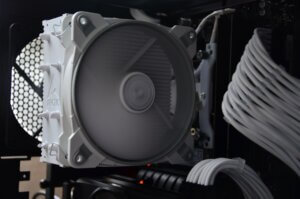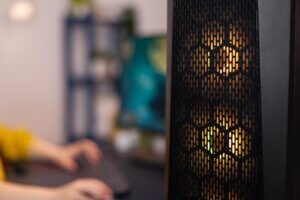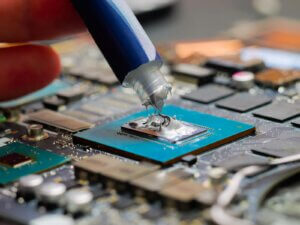With all the different terms that are used to describe computer hardware, you never know when you will come across a term that confuses most people. The term GPU is one of these terms. To most people, the term GPU means either a graphics processing unit or a graphics card.
Although the CPU and GPU are two different things, if you look closely, you will find that they have a lot in common. They do not just do the same job but share a lot of components since they were designed to work together. So, can you put a CPU cooler on a GPU?
In the last couple of years, the gaming industry has seen the creation of bigger and better devices. While gaming processors and graphics cards have increased in power, they haven’t remained the same size. What this means is that the standard CPU cooler is too heavy to be put on a graphics card. In this article, we’ll talk about the different issues that come with this and a way to solve them.
Potential Issues

A CPU (Central Processing Unit) is an essential part of every gaming PC gaming system. It is the part of the system which controls the entire computer and does the actual processing of data. A CPU works by executing commands and hence it needs a lot of cooling. A CPU is cooled by a CPU cooler which depends on the type of CPU you have.
A CPU cooler is an integral part of your PC’s cooling system to keep it running at optimal temperatures. But, there is a lot more to it than just applying thermal paste to the chip and throwing it on a stock cooler.
There are different types of CPUs (Intel and AMD), as well as different sizes, shapes, and mounting systems. Based on these types there are two types of CPU coolers: air coolers and liquid coolers.
Air coolers are generally the cheapest and most common type of PC cooling. They use fans to cool the processor. Liquid coolers are used for processors which work at very high temperatures like the GPU (Graphics Processing Unit).
If a CPU cooler is mounted on a GPU, The CPU fan will suck air from the GPU fan, so the GPU fan won’t be able to push air out of the case. This can cause the GPU and CPU temperatures to rise. In some cases, it could cause the CPU and GPU to overheat.
Can I Put A CPU Cooler On A GPU?
In short, putting a CPU cooler on a GPU is not a very good idea. In order to understand why putting a CPU cooler on a GPU is not a good idea, we need to understand how the CPU and GPU work.
A CPU (Central Processing Unit) works by performing calculations, at a set speed, and in a set order. The data input is stored in the CPU cache, then the CPU takes the data and performs calculations on it, and then stores the data in the CPU cache, which it then uses as the data input for the next calculation.
The graphics card works in much the same way, except the calculations are typically more complex, and the data input can come from different sources, and not just from the CPU cache. The problem with graphics cards is that they get hot, really hot. And hot air rises, which means hot air inside your computer case rises and is not exhausted out of your case.
There are some issues when putting a CPU cooler on a GPU. The CPU cooler fans are designed to push air through the fins. The blades of the fan are designed to concentrate the air through the fins. This means the fan will push air through the fins and out the sides.
The air will pass through the fins on the GPU but the fan will be pushing the air along the edges and out the sides. So the air that is supposed to flow through the fins will not be able to since the fan will be pushing the air along the edges. This means the fins won’t get any air flowing through them and will effectively block the air from flowing through the fins.
Will A CPU Cooler Fit On A Graphics Card?
There are two main reasons why a CPU cooler does not fit on a GPU. First, CPUs and GPUs serve different purposes. While a CPU is designed to perform a large number of calculations and tasks, a GPU is designed to perform a lot of complex calculations in a small amount of time.
Secondly, the CPU and GPU are generally not even compatible. The CPU is generally an x86 chip and the GPU is generally a GPU chip. For example, you cannot use an AMD CPU with an NVIDIA GPU.
The chipset is different. The plug is different. The pinout is different. The voltages are different and the pin layout is different.
If a CPU cooler is mounted on a graphics card, The CPU fan will suck air from the GPU fan, so the GPU fan won’t be able to push air out of the case. This can cause the GPU and CPU temperatures to rise. In some cases, it could cause the CPU and GPU to overheat.
The size of gaming graphics cards is often much better than a CPU unit and most likely won’t even be able to fit on a GPU, let alone cool one properly.
Is It Possible To Install CPU Cooler On A GPU?

In my opinion, you can install a cooler on a graphic card; by that I mean it is possible, but you may have to find a specific model cooler or know how to do some modifications. I do not think this is a good idea, but it is possible.
The type of cooler you would have to install depends on the model of your graphics card, but I believe that there are adapters that can make these types of changes.
First, you need to look at the sockets. If they are the same, then try first. If they are not the same, then remove the graphics card and try to install the CPU cooler on the graphic card socket. You can do it if you are careful.
If you have a high-end graphics card, you’re not going to be doing a lot of graphics-intensive tasks at the same time. In situations like this, you can put a CPU cooler on a graphics card. It’s important to note that it’s not the same process for a CPU and a graphics card.
This is because the CPU and GPU have different components. However, it’s easier than you might think to put a CPU cooler on a graphics card. It’s a simple process that can give your graphics card a performance boost without increasing the price. The details are discussed in the next section.
How to Cool A Gaming Graphics Card?
There are lots of different ways to cool a computer. With so many choices, it can be hard to know what to choose. What you need depends on how your computer is set up, what you’re using it for, and its size.
The first step to cooling your computer is to understand how it works. A computer’s CPU is the brain of the computer. It does all of the processing, and it can get pretty hot when it’s working hard. That’s why it needs a cooling system.
The CPU cooler, sometimes called a heatsink, draws heat away from the CPU. The heat is then turned into a different form of energy, usually heat, which makes the air around the computer a little warmer. The computer’s fans then use this heat to keep the air flowing through the computer so the CPU doesn’t get too hot.
If you’re struggling to mount a CPU cooler on your graphics card, here are some good tips to remember.
First, you want to make sure that the graphics card is actually meant to include a cooler. If it doesn’t include a cooler, you will either have to buy one separately or get a different graphics card. Also, you want to make sure that you have enough thermal paste to cover all of the surfaces of the cooler.
Some coolers require different amounts of paste, so be sure to read the instructions before you start mounting it. Finally, make sure you attach the cooler to the graphics card securely. You want the GPU to be able to operate at its maximum potential, at all times!
If you’re looking to overclock your graphics card to get a bit more power out of it, then you’ll need to make sure it’s properly cooled. With the right cooling system, there’s no reason why you can’t get another 100MHz out of your system.
The GPU is one of the most important parts of your desktop PC. If the GPU is too hot, it’ll be unstable and it can be damaged. Actually, most GPUs will automatically throttle down and lower their clock speed if they are too hot, but that’s not a good solution.
That’s why we need to get a cooler. My recommendation is the Noctua NH-D15.
If you have a computer with a GPU, finding out how to cool it can save you a lot of time and money! First, you need to find out if the GPU uses air or water cooling. If it uses air, keep the computer in an open space so air can flow through it, but not so much that it becomes dusty.
If it uses water, make sure that the water is circulating the GPU and not sitting in one spot. This way the GPU will remain cool, even after hours of use!
Wrapping Up

Whether you’re a PC gamer or not, it’s hard to deny the importance of a good graphics card. It’s capable of turning your modest desktop computer into a high-powered gaming one. In order to get the most out of your card, however, you’re going to have to upgrade some of the components.
The most important of these components is your graphics card cooler. They’re incredibly important because they cool down the card itself and therefore lower the temperature, which is vital to the lifespan of the product!
When installing a CPU cooler on a GPU, first figure out if the holes are the same at both ends. Then you need to open the backplate, remove the old cooler and install the new one in the same way the old one was installed, but in reverse.
It’s important to use the new thermal paste that comes with your CPU cooler when installing it on a GPU because if you don’t it won’t work properly and you’ll have to re-do the entire process. It can be hard to figure out how to install a CPU cooler on a GPU, but if you’re careful and follow the steps above you’ll be able to do it in no time!
Conclusion
CPUs and GPUs have different components, and they have different needs. For this reason, it’s best to have a separate CPU Cooler and a separate GPU Cooler.
A GPU Cooler will have a heatsink and fan, while a CPU Cooler will have a heatsink, fan, and a heat spreader to transfer the heat away from the CPU. CPUs and GPUs have different power needs, and a CPU Cooler can put out a lot of heat, so it’s best to use a CPU Cooler on the CPU and a GPU Cooler on the GPU.
However, yes, you can put a CPU cooler on a GPU. You can also put a GPU cooler on a CPU if you’d like. The concept is the same whether it is the CPU or GPU that is getting the extra cooling.
Author
-
Gaming For PC (or GFPC for short) is made up of a small team of gamers, content creators, editors, and web design experts.
View all posts












